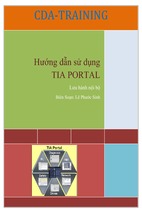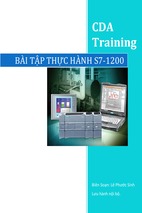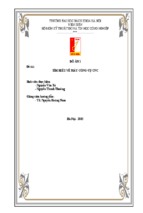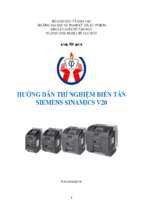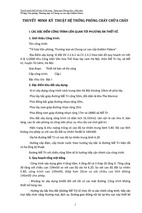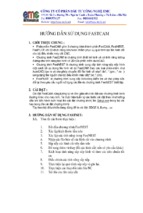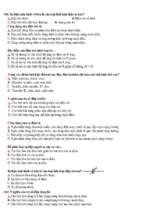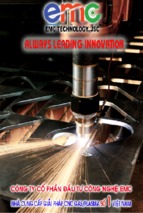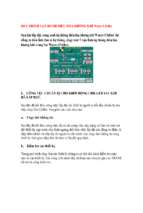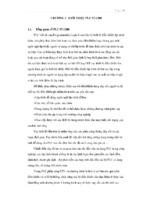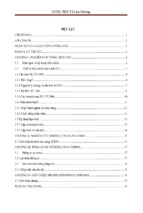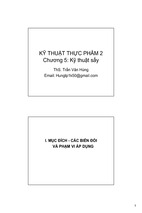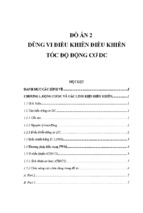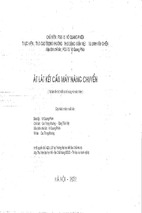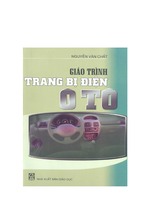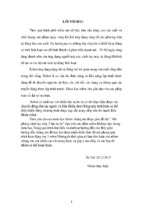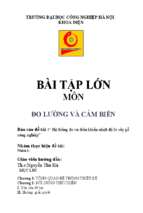Mô tả:
Sustainable Manufacturing and Factory
Planning
Remanufacturing
05.04.2017
Technische Universität Berlin
Institute for Machine Tools and Factory Management
Univ.-Prof. Dr.-Ing. Holger Kohl
© IWF TU Berlin
Page 1
Table of Contents
Global Resources
Product Life Cycle Perspectives
Remanufacturing Processes
Remanufacturing Cases
Chances for Implementation
Literature and References
Technische Universität Berlin
Institute for Machine Tools and Factory Management
Univ.-Prof. Dr.-Ing. Holger Kohl
Page 2
Table of Contents
Global Resources
Product Life Cycle Perspectives
Remanufacturing Processes
Remanufacturing Cases
Chances for Implementation
Literature and References
Technische Universität Berlin
Institute for Machine Tools and Factory Management
Univ.-Prof. Dr.-Ing. Holger Kohl
Page 3
Environmental and Social Challenges
Distribution of wealth among global population
Challenge:
How to convert from 1/5 of
global population exploiting
4/5 of global resources to
acceptable distribution of
wealth within ecological limits.
Technische Universität Berlin
Institute for Machine Tools and Factory Management
Univ.-Prof. Dr.-Ing. Holger Kohl
Source: [Dfg-13a]
Page 5
Scenarios on Oil Availability
Caused by the finiteness and the limited extraction possibilities from non-renewable resources like oil,
aluminum, copper and lead, the prices of raw material are currently rising.
The exact date from peak oil, the moment when the oil extraction volume is stagnating or reducing is
planned according to the estimations between 2010 and 2100.
trendlines.ca
Illustration:
The most
important peak
oil scenarios
1950 1975 2000 2025 2050 2075 2100 2125 2150
Technische Universität Berlin
Institute for Machine Tools and Factory Management
Univ.-Prof. Dr.-Ing. Holger Kohl
2175 2200
2225 2250 2275 2300
Page 8
Energy Demand from 1980 to 2035
The worldwide primary energy consumption increased by 25% within the last 10 years
Projections according to IEA
Gtou
Other energy sources
Biomass
Hydraulic energy
Nuclear energy
Natural gas
Legend:
Gtou = Giga-ton Oil unity
1 Gtou = 1 billion tons
Coal
Oil
Technische Universität Berlin
Institute for Machine Tools and Factory Management
Univ.-Prof. Dr.-Ing. Holger Kohl
Source: [IEA-12]
Page 9
Rising Raw Material Costs – Example of Crude Oil Price
Development from crude oil price
Public debt crisis
Period 1960-2012
Bank crisis
www.tecson.de
Oil crisis
Technische Universität Berlin
Institute for Machine Tools and Factory Management
Univ.-Prof. Dr.-Ing. Holger Kohl
Page 10
Table of Contents
Global Resources
Product Life Cycle Perspectives
Remanufacturing Processes
Remanufacturing Cases
Chances for Implementation
Literature and References
Technische Universität Berlin
Institute for Machine Tools and Factory Management
Univ.-Prof. Dr.-Ing. Holger Kohl
Page 12
Product – Product Life Cycle
Economic View
Economic product life cycle
Covers the duration of the presence of a product in the market
Product life cycles vary for different product types
Automotive: 7 years
Mobile phones: 6 month
Product
modification
Product
introduction
Product life cycle
new life cycle
Product
elimination
Profit
and
Turnover
Legend:
Turnover:
Product profit:
+
0
-
Development Introduction
Technische Universität Berlin
Institute for Machine Tools and Factory Management
Univ.-Prof. Dr.-Ing. Holger Kohl
Growth
Maturity
Saturation
Decline
Relaunch
Recycling/
Disposal
Source: [Pah-07]
Page 13
Product – Product Life Cycle
Technological View
Technological Product Life Cycle (≠ economic product life cycle)
Integrated model that covers all areas of a product‘s existence
Recycling
Raw material
production
•Selection of
material
•Make-or-Buy
Production
•Manufacturi
ng
•Assembly
Distribution
Remanufacturing
Use Phase
•Design
•Usage
•Maintenance
Final
storage
Technische Universität Berlin
Institute for Machine Tools and Factory Management
Univ.-Prof. Dr.-Ing. Holger Kohl
Re-use
Valorisation
Collection
Incineration
Transport (from product or part)
Disposal
Source: [Sel-00]
Page 14
Business Approach Resources Cycles and “Selling Use Instead of Products”
Approach
Use of material and components of old/used products to manufacture new products
Primary raw materials (e.g. obtained by excavation) with the equivalent of € 3.7 Billion are substituted
by secondary raw material (e.g. obtained out of used products or waste) in Germany, 2007
Elements of Cycle economies, including business opportunities
Information Management
Facility Management
Product
Development
Production
Distribution
Service-engineering
Logistics
Pool Management
Selling Utilization
Use
Reassembly
Product data preparation
Redistribution
Cleaning,
Control,
Processing
Reprocessing
Disposal
Disassembly
Traditional material flow
Product recycling flow
Remanufacturing
Product recycling
Material Recycling flow
Maintenance
Repair
Product data preparation
Technische Universität Berlin
Institute for Machine Tools and Factory Management
Univ.-Prof. Dr.-Ing. Holger Kohl
Cleaning methods
Separation tools
Source: [Bmu-09], [Sel-05]
Page 15
Waste Hierarchy according the European Union Law
Best solution
Reduce
Waste hierarchy (EU-Directive 2008/98/EG
from November 19th, 2008)
The waste hierarchy is valid in the EU as the
standard for the correct waste management.
Introduction of extended producer
Remanufacture
Recycle
Incinerate
responsibility is one of the means to
support:
the design and production of goods which
take into full account and facilitate the
efficient use of resources during their whole
life-cycle including their repair, re-use,
disassembly and recycling
without compromising the free circulation of
goods on the internal market.
Dispose
Worst solution
Technische Universität Berlin
Institute for Machine Tools and Factory Management
Univ.-Prof. Dr.-Ing. Holger Kohl
This directive should help move the EU
closer to a ‘recycling society’, seeking to
avoid waste generation and to use waste as
a resource.
Source: [Eup-08]
Page 16
Disposal and Incineration
Best solution
Reduce
Incineration of both hazardous and harmless
wastes causes emissions of substances
which pollute the air, water and soil and
have harmful effects on human health.
The European Union (EU) shall impose strict
Remanufacture
Recycle
operating conditions and technical
requirements on waste incineration plants
and waste co-incineration plants.
Incinerator
Waste hopper
Incinerate
Bag filer
www.gec.jp
Waste crane
Boiler
Reception hall
Dispose
Worst solution
Technische Universität Berlin
Institute for Machine Tools and Factory Management
Univ.-Prof. Dr.-Ing. Holger Kohl
Ash
Induced draft fan
discharger
Electric room
Ash storage
Example of municipal waste incineration facility: Mitsubishi stoker
incineration system
Waste storage
Source: [Eup-00b]
Page 17
Recycling End-of-Life (EOL) Products
Best solution
Reduce
Remanufacture
The objective of recycling is to recover and
reuse the material of the products.
In recycling the identity and functionality of
the product is lost and the goal is to return
the product to a raw material form to be
used in future manufacturing process.
Metals
collection
Recycle
Old mobile
phone
Dispose
Metals
recycling
Valuable
metals source
www.umicore.com
Incinerate
Worst solution
Example of recycling: precious metals in old mobile phones
Technische Universität Berlin
Institute for Machine Tools and Factory Management
Univ.-Prof. Dr.-Ing. Holger Kohl
Source: [Eup-08]
Page 18
Targeted Recycling Percentages in the EU WEEE Directive
Waste electrical and electronic equipment (2002/96/EC)
Large electrodomestical appliances
Vending machines
IT and telecommunications appliances
Entertainement electronics
Small electrodomestical applicances
Lightening devices
Electric and electronic tools
Toys, sport and leisure devices
Surveillance and controlling devices
Gas discharge devices
0%
20%
40%
60%
80%
100%
Weight percentage
blau = Reutilisation
Technische Universität Berlin
Institute for Machine Tools and Factory Management
Univ.-Prof. Dr.-Ing. Holger Kohl
rot = Valorisation
grün = Disposal
Source: [Bun-05]
Page 19
Remanufacturing EOL Products
Best solution
Reduce
Remanufacture
Remanufacturing is the rebuilding of a product to
specifications of the original manufactured product using a
combination of reused, repaired and new parts.
The purpose of remanufacturing is providing the used
products the same level of quality than a new original
manufactured product.
There is a total disassembly of the product and several
Recycle
Incinerate
inspections of the components of the product allowing
remanufactured products to offer the same guarantee as the
new manufactured products.
The components are reprocessed but keep their original form
all along the process, thus keeping encapsulated value added.
mercedes-benz.ca
Dispose
Worst solution
Technische Universität Berlin
Institute for Machine Tools and Factory Management
Univ.-Prof. Dr.-Ing. Holger Kohl
Mercedes-Benz Canada – Remanufacturing Centre
Source: [Joh-14]
Page 20
Remanufacturing preserves the product‘s embedded value
Product value retained in a
product
85%
8%
Source of value in the product:
Percentages show in this chart are illustrative only. Actual percentages vary with product type
Technische Universität Berlin
Institute for Machine Tools and Factory Management
Univ.-Prof. Dr.-Ing. Holger Kohl
Source: [Hau-12]
Page 21
Reducing Waste
Best solution
Reduce
Remanufacture
The best strategy for waste management is
to design products using less materials
alongside their lifecycle.
Packaging is a great example in how
companies can manage to reduce waste
without altering product characteristics.
Recycle
Dispose
Worst solution
Technische Universität Berlin
Institute for Machine Tools and Factory Management
Univ.-Prof. Dr.-Ing. Holger Kohl
www.wasteawarenesswales.org.uk
joswinson.org.uk
Incinerate
Over packaged bananas
Example of packaging reduction
Page 22
Technical Approach
End-of-Life Strategies Within Product Life Cycle
Remanufacturing is typically
a more efficient means of
material recirculation than
recycling.
Remanufacturing retains
more of the energy
associated with the original
conversion of raw materials
to finished product.
Similarly, component reuse
will typically result in lower
overall material and energy
use than component
remanufacturing.
Technische Universität Berlin
Institute for Machine Tools and Factory Management
Univ.-Prof. Dr.-Ing. Holger Kohl
Source: [Nas-06]
Page 23
Table of Contents
Global Resources
Product Life Cycle Perspectives
Remanufacturing Processes
Remanufacturing Cases
Chances for Implementation
Literature and References
Technische Universität Berlin
Institute for Machine Tools and Factory Management
Univ.-Prof. Dr.-Ing. Holger Kohl
Page 24
- Xem thêm -

